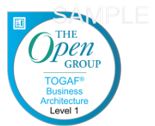In the business sector, business architecture is a discipline that “represents holistic, multidimensional business views of: capabilities, end‐to‐end value delivery, information, and organizational structure; and the relationships among these business views and strategies, products, policies, initiatives, and stakeholders.
In application, business architecture provides a bridge between an enterprise business model and enterprise strategy on one side, and the business functionality of the enterprise on the other side. It often enables the Strategy to Execution methodology.
The business architect role is a strategic one that works at an enterprise level across business units. It facilitates the application of business architecture for business and IT value. It builds and maintains the business architecture knowledgebase and provide input to and assist with the internal business architecture practice.
Enterprise architecture provides a strategic planning framework that relates and aligns information technology with the business functions that it supports. In theory, enterprise architecture teams only perform enterprise technical architecture only but the business Architect role goes way beyond and deals with the business of the enterprise overall.
The purpose of the TOGAF Business Architecture Level 1 credential is to provide validation that individuals have knowledge and understanding of Business Modelling, Business Capabilities, TOGAF Business Scenarios, Information Mapping, and Value Streams and how to apply them in development of a Business Architecture based.
The purpose of the TOGAF Business Architecture Level 1 certification credential is to provide validation that individuals have knowledge and understanding of Business Modelling, Business Capabilities, TOGAF Business Scenarios, Information Mapping, and Value Streams and how to apply them in development of a Business Architecture based on the TOGAF® Standard, Version 9.2.
The learning objectives for this certification credential focus on knowledge and comprehension. This certification credential leads to the award of an Open Badge.
The Value of this Certification Credential

Individuals who earn this certification credential will have demonstrated their understanding of:
The course is design for:
Travelling Participants:
Good News! The Open Group has just announced the availability of Pearson VUE OnVUE Online Proctoring.
With Online Proctoring, candidates who would need to travel, can now save money and time by taking their Certification Exams at home or at the office. For more information please click here.
| No public courses currently scheduled. Please contact ALC. |